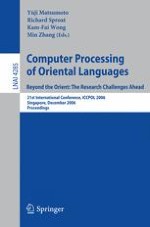2006 | Buch
Computer Processing of Oriental Languages. Beyond the Orient: The Research Challenges Ahead
21st International Conference, ICCPOL 2006, Singapore, December 17-19, 2006. Proceedings
herausgegeben von: Yuji Matsumoto, Richard W. Sproat, Kam-Fai Wong, Min Zhang
Verlag: Springer Berlin Heidelberg
Buchreihe : Lecture Notes in Computer Science
